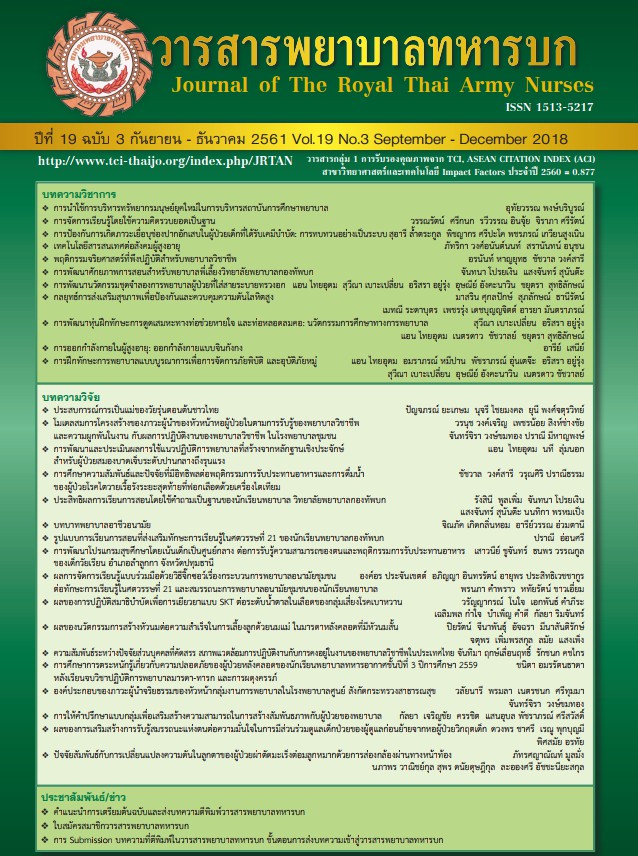Health Promotion Strategies to Prevent and Control high blood pressure
Keywords:
high blood pressure, health promotion strategies, prevention and controlAbstract
Hypertension is a chronic disease that is considered to be a risk in all health areas as seen in the rapidly increasing rate of illness and the impact it has on lives. Appropriate preventing and controlling high blood pressure play an important role to reduce the deathly complication. The guidelines for promoting healthy activities to prevent and control high blood pressure in all sectors are varied. If the health promotion strategies are utilized to be the key message, the problem of high blood pressure will be decreased. Therefore, this paper presents the prevention strategies to control hypertension worldwide has been conducted in these five areas, including; 1.Determine political strategies, 2. Develop health care systems, 3. Create supportive environment, 4. Increase community action, and 5. Apply health promotion and health education.
Downloads
References
2. Strategy and Planning Division, Office of Permanent Secretary, Ministry of Public Health. Public Health Statistics A.D.2014. Nonthaburi: Strategy and Planning Division; 2015. (in Thai)
3. World Health Organization (WHO). A global brief on hypertension Silent killer, global public health crisis. Geneva: WHO Press; 2013.
4. Strategy and Planning Division, Office of Permanent Secretary, Ministry of Public Health. Public Health Statistics A.D.2017. Nonthaburi: Strategy and Planning Division; 2018.
5. Benjamin EJ, Blaha MJ, Chiuve SE, et al. Heart disease and stroke statistics-2017 updates: a report from the American Heart Association. Circulation. 2017; 135(10): e146–e603.
6. Thai Hypertension Society. Thai Guidelines on The Treatment of Hypertension. 2012 Update 2015; 2015. (in Thai)
7. Whelton, Paul K. et al. ACC/AHA/AAPA/ABC/ACPM/AGS/APhA/ASH/ASPC/NMA/PCNA. Guideline for the Prevention, Detection, Evaluation, and Management of High Blood Pressure in Adults: A Report of the American College of Cardiology/American Heart Association Task Force on Clinical Practice Guidelines. Journal of the America College of Cardiology, 2018; 71: e127-e248.
8. Zena LS, Susan ER. Diagnosis of hypertension and lifestyle modifications for its management. BC Medical Journal. 2012; 54(8). 392-398.
9. U.S. Department of Health and Human Services. The Seventh Report of the Joint National Committee on Prevention, Detection, Evaluation and Treatment of High Blood Pressure; 2004.
10. De Martinis JE. Management of client with hypertensive disorders. In: Black JM, Hawks JH, editors. Medical-surgical nursing: clinical management for positive outcomes. Vol 2. 8th ed. Philadelphia: Saunders Elsevier; 2009.
11. Chobanian AV, Bakris GL, Black HR, et al. The seventh report of the Joint National Committee on prevention, detection, evaluation, and treatment of high blood pressure: The JNC 7 report. JAMA. 2003; 289(19): 2560-72. doi: 10.1001/jama.289.19.2560.
12. Dorough AE, Winett RA, Anderson ES, Davy BM, Martin EC, Hedrick V. Dash to wellness: Emphasizing self-regulation through e-health in adults with prehypertension. Health Psychology. 2014; 33(3): 249–54.
13. Brooks CJ, Barrett J, Daly J, Lee R, Blanding N, McHugh A, et al. A Community-Level Sodium Reduction Intervention, Boston, 2013–2015. American Journal of Public Health 2017; 107(12): 1951–7.
14. Ribeiro F, Ribeiro IP, Alves AJ, et al. Effects of exercise training on endothelial progenitor cells in cardiovascular disease. America Journal of Physical Medicine& Rehabilitation. 2013; 92(11): 1020-30. doi: 10.1097 PHM.0b013e31829b4c4f.
15. Semlitsch T, Jeitler K, Hemkens L, Horvath K, Nagele E, Schuermann C, et al. Increasing Physical Activity for the Treatment of Hypertension: A Systematic Review and Meta-Analysis. Sports Medicine. 2013; 43(10): 1009–23.
16. Mushtaq M, Najam N. Coping Strategies of Stress Used by People Suffering from Hypertension. Pakistan Journal of Psychology. 2014; 45(2): 3–22.
17. Pantaewan P. Ecological Model and Health Behavior Change. Journal of The Royal Thai Army Nurses. 2017; 18(2): 7-15. (In Thai)
18. WHO Regional Office for South-East Asia. Expert Meeting on Population Sodium Reduction Strategies for Prevention and Control of Noncommunicable Diseases in the South-East Asia Region; 2012.
19. Sodium Working Group. Sodium Reduction Strategy for Canada - Recommendations of the Sodium Working Group. Report, 1-61. Ottawa, Health Canada. 2010
20. Niessen MAJ, van der Hoeven NV, van den Born B-JH, van Kalken CK, Kraaijenhagen RA. Home blood pressure measurement as a screening tool for hypertension in a web-based worksite health promotion programme. European Journal of Public Health. 2014; 24(5): 776–81.
21. Gupta R, Khedar RS, Panwar RB. Strategies for Better Hypertension Control in India and Other Lower Middle Income Countries. The Journal Of The Association Of Physicians Of India. 2016; 64(9): 58–64.
22. Office of the National Economic and Social Development Board, Ministry of Publi Health and Mahidol University. Thailand healthy lifestyle strategic plan, 2011-2020. Bangkok; 2010. (In Thai)
23. Vichai Tienthavorn.Surveillance,Control and Prevention System oF DM and HT in Thailand: Policy to Action. Bangkok: The Agriculural Co-operation Federation of Thailand,LTD; 2013.
24. World Health Organization. Milestones in Health Promotion: Statements from global conferences. Switzerland: WHO Press; 2009.
Downloads
Published
How to Cite
Issue
Section
License
บทความหรือข้อคิดเห็นใดใดที่ปรากฏในวารสารพยาบาลทหารบกเป็นวรรณกรรมของผู้เขียน ซึ่งบรรณาธิการหรือสมาคมพยาบาลทหารบก ไม่จำเป็นต้องเห็นด้วย
บทความที่ได้รับการตีพิมพ์เป็นลิขสิทธิ์ของวารสารพยาบาลทหารบก
The ideas and opinions expressed in the Journal of The Royal Thai Army Nurses are those of the authors and not necessarily those
of the editor or Royal Thai Army Nurses Association.






